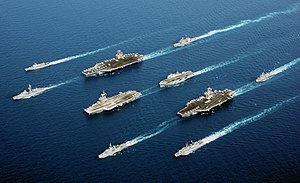
Back تكتيكات بحرية Arabic Tácticas navales Spanish تاکتیک نیروی دریایی FA טקטיקה ימית HE Tattica navale Italian 海戦術 Japanese Táticas navais Portuguese Taktikang pandagat TL Donanma taktikleri Turkish Chiến thuật hải quân VI
| Part of a series on |
| War (outline) |
|---|
 |

Naval tactics and doctrine is the collective name for methods of engaging and defeating an enemy ship or fleet in battle at sea during naval warfare, the naval equivalent of military tactics on land.
Naval tactics are distinct from naval strategy. Naval tactics are concerned with the movements a commander makes in battle, typically in the presence of the enemy. Naval strategy concerns the overall strategy for achieving victory and the large movements by which a commandant or commander secures the advantage of fighting at a place convenient to himself.
Modern naval tactics are based on tactical doctrines developed after World War II, following the obsolescence of the battleship and the development of long-range missiles. Since there has been no major naval conflict since World War II, apart from the Indo-Pakistani Naval War of 1971 and the Falklands War, many of these doctrines reflect scenarios developed for planning purposes. Critics argue that the collapse of the Soviet Union and the subsequent reduction in the size and capabilities of the Russian Navy renders most such fleet-on-fleet scenarios obsolete.